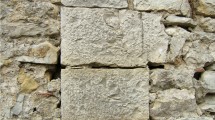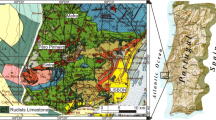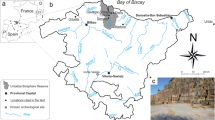Abstract
The Arrábida Breccia is a type of chromatic rock with a very unusual texture, appearing only in the current geographical area of the Natural Park of Arrábida, and thus, its extraction is definitively finished. Due to its petrographic nature, it is very sensitive to weathering, particularly to rainwater. It has had numerous uses for at least 2000 years since the occupation of Iberia by the Romans, and which evolved over time from exterior to interior structures. Since the beginning of the Baroque, it is almost exclusively linked to the interior decorative arts, in polished finishing. Its use had a greater expression linked to the Gothic-Manueline style, closely associated with the epic Portuguese, roughly in the transition in fifteenth to sixteenth centuries particularly during the reign of King Manuel I who would have particular preference for this rock. Its use is characterised by being quite confined, especially as the resource has always been relatively scarce regarding known deposits. Although most of the known applications are located in Portugal, especially in the regions of Setúbal and Lisbon, there are also examples of its application in other countries, namely in the Mediterranean Europe and Brazil, largely in buildings classified as of National Interest and in building classified as World Heritage or Architectural Heritage (UNESCO). Due to the above facts, the need to preserve some extracted but not used blocks is also discussed in this work both for the purposes of preservation and restoration of monuments as well as the valuation of the old mines for educational and recreational purposes.






























Similar content being viewed by others
References
Afonso LU (2016) A Charola de Tomar como uma obra de arte total. In: Frazão I, Afonso LU (eds) A Charola de Tomar: Novos dados, novas interpretações. Direção-Geral do Património Cultural, Lisboa, pp 69–83
Aires-Barros L (2001) As rochas dos monumentos portugueses: tipologias e patologias. Instituto Português do Património Arquitetónico, Lisboa
Anonymous Author (1842) Portugal VII. Setubal 2°. O Panorama 1(2):113–115
Azerêdo AC, Wright VP, Ramalho MM (2002) The Middle-Late Jurassic forced regression and disconformity in central Portugal: eustatic, tectonic and climatic effects on a carbonate ramp system. Sedimentology 49(6):1339–1370. https://doi.org/10.1046/j.1365-3091.2002.00501.x
Azerêdo AC, Duarte LV, Henriques MH, Manuppella G (2003) Da dinâmica continental no Triásico aos mares no Jurássico Inferior e Médio. Cad. Geol. Portugal, Inst. Geol. Mineiro, p 43
Brandão R (1924) Guia de Portugal, 1° Volume. Generalidade – Lisboa e Arredores. Fund, Calouste Gulbenkian, Lisboa
Carita H (2007) – Le palais de Santos – L’ambassade de France à Lisbonne. Chandeigne, Paris
Carita R (1998) Sé do Funchal. In: SIPA, Direção Geral do Património Cultural http://www.monumentos.gov.pt/Site/APP_PagesUser/SIPA.aspx?id=5015 Accessed 23 July 2017
Carita R (2001) Pelourinho do Funchal. In: SIPA, Direção Geral do Património Cultural http://www.monumentos.gov.pt/site/APP_PagesUser/SIPA.aspx?id=30112 Accessed 24 July 2017
Carqueijeiro E (ed.) et al (1996) O Desafio da Arrábida – 20 anos de histórias do Parque Natural da Arrábida. PNA - Instituto da Conservação da Natureza, Setúbal
Castela (2010) Igreja do Antigo Mosteiro de Jesus e Claustro (Setúbal) (1ª parte). http://www.portugalnotavel.com/igreja-do-antigo-mosteiro-de-jesus-e-claustro-setubal/, Accessed 5 June 2017
Castro e Solla L (1969) Ainda os Mármores Portugueses. Boletim de Minas Serviço Fomento Mineiro 6(4):1–335
Choffat P (1908) Essai sur la tectonique de la chaîne de l’Arrabida. Com. Serv. Geol. Portugal
Correia AP (1985) As Pedreiras do Parque Natural da Arrábida: contribuição para o estudo das técnicas de recuperação e integração paisagística. Instituto Superior Agronomia, Lisboa
Costa AG, Calixto C, Silva ME, Becerra J (2003) Rochas Ornamentais e de Revestimento: Estudos a partir do Patrimônio Construído e de Projetos Arquitetônicos Recentes. In: Villas Boas R, Calvo B, Peiter C (eds) Iberoeka en Mármoles y Granito, Salvador de Bahia, pp 139–165
Eschwege B (1837) Memoria geognóstica, prospecto geognóstico dos arredores de Setúbal. Mem. Academia Ciências Lisboa XII(1):53–63
Escorihuela J (2017) The role of the geotouristic guide in earth science education: towards a more critical society of land management. Geoheritage. https://doi.org/10.1007/s12371-017-0236-1
European Commission Panel Report (2014) European Heritage Label. https://ec.europa.eu/programmes/creative-europe/sites/creative-europe/files/library/ehl-2014-panel-report.pdf Accessed 4 June 2017
Gil D, Calvet N (1992) Palácio da Pena. In: Os mais belos Palácios de Portugal, Verbo, Lisboa, pp 148–155
Góis A (2005) Fatores determinantes do retábulo e sua morfologia na Cidade do Salvador. Dissertation Univ, São Paulo
Gomes PV (2003) Se eu cá tivera vindo antes... Mármores Italianos e Barroco Português. Artis – Revista do Instituto de História da Arte da Faculdade de Letras de Lisboa 2:181–196
Hose TA (2000) European “geotourism”—geological interpretation and geoconservation promotion for tourists. In: Barettino D, Wimbledon WAP, Gallego E (eds) Geological heritage: its conservation and management, Madrid, pp 127–146
ICOMOS – International Council on Monuments and Sites (2008) Illustrated glossary on stone deterioration patterns. ICOMOS. https://www.icomos.org/publications/monuments_and_sites/15/pdf/Monuments_and_Sites_15_ISCS_Glossary_Stone.pdf. Accessed 27 June 2017
Inverno C, Manuppella G, Zbyszewsky G (1986) Geological map of Portugal, scale 1/50.000, sheet 42-C (Santiago do Cacém)
Kullberg JC (2000) Evolução Tectónica Mesozoica da Bacia Lusitaniana. Dissertation Univ, Nova de Lisboa
Kullberg JC, Machado S, Ramalho M (2006) Legenda da Carta Geológica de Portugal na escala 1:100 000 da Área Metropolitana de Lisboa, Folhas Norte e Sul. In: Costa C (coord.) Carta Geológica de Portugal na escala 1:100 000. Inst. Geol. Mineiro, Lisboa
Kullberg JC, Rocha RB, Soares AF, Rey J, Terrinha P, Azerêdo AC, Callapez P, Duarte LV, Kullberg MC, Martins L, Miranda JR, Alves C, Mata J, Madeira J, Mateus O, Moreira M (2013) A Bacia Lusitaniana: Estratigrafia, Paleogeografia e Tectónica. In: Dias R, Araújo A, Terrinha P, Kullberg JC (eds) Geologia de Portugal. Vol. II – Geologia Meso-cenozóica de Portugal, Livraria Escolar Editora, Lisboa, pp 317–368
Kullberg JC, Rocha RB (2014) The Upper Jurassic of the Lusitanian Basin: importance of linking lithostratigraphy, chronostratigraphy and cartography. I—the end of the 2nd rifting episode. Comunicações Geológicas 101(I):459–462
Leinfelder R (1983) New mapping results on sheet Setubal (Sesimbra to Portinho da Arrábida, Serra da Arrábida, Portugal). Com Serv Geol Port 9(2):295–324
Manuppella G, Antunes MT, Pais J, Ramalho MM, Rey J (1994) Geologic map of Portugal scale 1/50 000, sheet 38-B, Setúbal. Inst. Geol. Min, Lisboa
Martins OR (1974) A indústria extractiva das rochas ornamentais de Portugal Metropolitano em 1973. Boletim de Minas Serviço Fomento Mineiro 11(4):255–284
Mendonça I (1992a) – Forte de São Filipe/Pousada de São Filipe In SIPA, Direção Geral do Património Cultural http://www.monumentos.gov.pt/Site/APP_PagesUser/SIPA.aspx?id=2007Accessed 18 July 2017
Mendonça I (1992b) – Mosteiro de Jesus In SIPA, Direção Geral do Património Cultural http://www.monumentos.gov.pt/Site/APP_PagesUser/SIPA.aspx?id=3439 Accessed 20 July 2017
Mendonça I (1992c) – Cruzeiro de Setúbal In SIPA, Direção Geral do Património Cultural http://www.monumentos.gov.pt/Site/APP_PagesUser/SIPA.aspx?id=2110 Accessed 15 July 2017
Mendonça I (1992d) – Convento e Igreja de Santiago de Palmela In SIPA, Direção Geral do Património Cultural http://www.monumentos.gov.pt/Site/APP_PagesUser/SIPA.aspx?id=2157Accessed 22 July 2017
Michiels L (1937) Les Marbres Portugais. Sep. Bulletin de la Casa de Portugal d’Anvers, Anvers 1–4
Moura C (1986) O Limiar do Barroco. História da Arte em Portugal, Publicações Alfa, Lisboa 8:1–184
Museu de Arqueologia e Etnografia do distrito de Setúbal (Assembleia distrital de Setúbal) (n.d.) Calçada Romana do Viso. Vertical information outdoors, Junta de Freguesia da Anunciada
Noé P (2016) Castelo de Tomar. In: SIPA, Direção Geral do Património Cultural http://www.monumentos.gov.pt/Site/APP_PagesUser/SIPA.aspx?id=3390. Accessed 25 July 2017
Pereira MF, Ribeiro C, Gama C, Drost K, Chichorro M, Vilallonga F, Hofmann M, Linnemann U (2017) Provenance of upper Triassic sandstone, southwest Iberia (Alentejo and Algarve basins): tracing variability in the sources. Int J Earth Sci (Geol Rundsch) 106(1):43–57. https://doi.org/10.1007/s00531-016-1295-2
Pinto AL, Meireles F, Cambotas MC (2006) Arte em Portugal. Colecção A Grande História da Arte. Público/Porto Editora, Porto
Prego AM (2008) A Brecha da Arrábida: perspectiva transdisciplinar de um georrecurso extinto. Universidade Nova de Lisboa, Dissertation Faculdade de Ciências e Tecnologia
Prego AM, Kullberg JC (2010) D. Manuel I e a “Brecha da Arrábida”: relato de uma conjugação marcante no património edificado nacional. Revista Electrónica de Ciências da Terra |Geosciences On-line Journal 15(7):1–4
Reis JR (1958) Histórias da região de Setúbal e Arrábida. In: Centro de Estudos Bocageanos (2003) – Setúbal. Centro de Estudos Bocageanos, Setúbal I:1–212
Ribeiro JR, Bento AC (2004) Imagens da Península da Arrábida no Século XIX: o Panorama (1837–1868) e Archivo Pittoresco (1857–1868). Edições LASA, Setúbal
Santos CE (2008) A Charola Templária de Tomar – Uma Construção Românica entre o Oriente e o Ocidente. Revista Medievalista online 4:1–24
Silva CT, Cabrita MG (1966) O problema da destruição da povoação romana de Troia de Setúbal. Sep. Revista Guimarães 76:1–12
Silva JCV (1990) Setúbal. Colecção Cidades e Vilas de Portugal. Editorial Presença, Lisboa
Silva ZCG (2007) O Lioz Português. De lastro de navio a arte na Bahia. Edições Afrontamento, Porto
Silva ZCG (2017) Lioz—a royal stone in Portugal and a monumental stone in Colonial Brazil (in this volume)
Sharpe D (1841) On the geology in the neighbourhood of Lisbon. Transactions of the Geol. Soc. London, 1, 11 and 13(VI):123–124
Soares AF, Duarte LV (1997) Tectonic and eustatic signatures in the Lower and Middle Jurassic of the Lusitanian Basin. Comunicaciones IV Congreso Jurásico España 111–114
Sousa FLP de (1897) Subsídios para o estudo dos calcários do distrito de Lisboa. Sep. Rev. Engenharia Militar 9:270–279
Terrinha P, Ribeiro C, Kullberg JC, Lopes C, Rocha R, Ribeiro A (2002) Short-lived compressive episodes during Mesozoic rift tectonics in the Algarve Basin, South Portugal: the cause of interruption of marine communication around the SW corner of Iberia in the Jurassic. J Geology 110(1):101–113. https://doi.org/10.1086/324206
Wright VP, Wilson RCL (1985) Lacustrine carbonates and source rocks from the Upper Jurassic of Portugal. Int. Assoc. Sed. European Meeting Abstracts, pp. 487–490
Wright VP, Wilson RCL (1987) A Terra Rossa-like paleosol complex from the Upper Jurassic of Portugal. Sedimentology 34(2):259–273. https://doi.org/10.1111/j.1365-3091.1987.tb00776.x
Acknowledgements
The authors wish to thank all those who have supported us permanently during the work leading to this result. In the first place to two great women, Graça and Leonor, then to our friend Jorge Hall for his very careful and critical reading of the text and the revision of English. We wish to formally thank the following personalities and entities for their great openness that allowed us to obtain images, photography and video, including by drone, without which the work would lose a good part of its value. Namely (1) to the French Embassy in Portugal, in the person of the Ambassador Jean-Michel Casa, regarding the Palace of Santos (Lisbon); (2) to the High Reverend Bishop of Setúbal D. José Ornelas Carvalho and the Vicar General of the Diocese, as well as the Setúbal Municipality, through the Culture Sector and the Museum of Setúbal, regarding the Convent of Jesus (church and cloisters) as well as to Cristina Coelho in the quality of Environment Advisor in the Environment Sector; (3) the Administration of the Sintra’s Montes da Lua Parks and the curators and senior technicians who accompanied us in the palaces of Pena and Queluz; (4) to Madam Director of the Department of Nature Conservation and Forests of Lisbon and Vale do Tejo and Director of the Natural Park of Arrábida, Maria de Jesus Fernandes, and the senior technicians Ana Sofia Palma and César Monteiro, regarding the authorisation to overfly the area of Jasper Quarry and field monitoring; and (5) our colleague Antônio Gilberto Costa from the Minas Gerais Federal University (Brazil) for sending us photographs from applications of the Arrábida Breccia in Brazil. We want to acknowledge our colleague Manuel Gonçalves da Silva for his very careful reading and comments to the English phrasing and also to the reviewers for their constructive comments and suggestions.
Author information
Authors and Affiliations
Corresponding author
Electronic Supplementary Material
Rights and permissions
About this article
Cite this article
Kullberg, J.C., Prego, A. The Historical Importance and Architectonic Relevance of the “Extinct” Arrábida Breccia. Geoheritage 11, 87–111 (2019). https://doi.org/10.1007/s12371-017-0272-x
Received:
Accepted:
Published:
Issue Date:
DOI: https://doi.org/10.1007/s12371-017-0272-x




